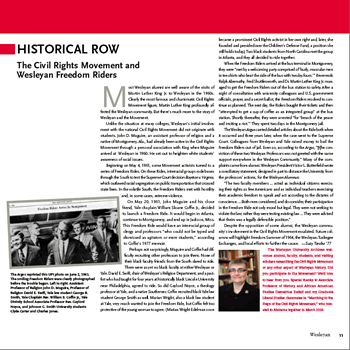HISTORICAL ROW: THE CIVIL RIGHTS MOVEMENT AND WESLEYAN FREEDOM RIDERS
 Most Wesleyan alumni are well aware of the visits of Martin Luther King Jr. to Wesleyan in the 1960s. Clearly the most famous and charismatic Civil Rights Movement figure, Martin Luther King profoundly affected the Wesleyan community. But there’s much more to the story of Wesleyan and the Movement.
Most Wesleyan alumni are well aware of the visits of Martin Luther King Jr. to Wesleyan in the 1960s. Clearly the most famous and charismatic Civil Rights Movement figure, Martin Luther King profoundly affected the Wesleyan community. But there’s much more to the story of Wesleyan and the Movement.
Unlike the situation at many colleges, Wesleyan’s initial involvement with the national Civil Rights Movement did not originate with students. John D. Maguire, an assistant professor of religion and a native of Montgomery, Ala., had already been active in the Civil Rights Movement through a personal association with King when Maguire arrived at Wesleyan in 1960. He set out to heighten white students’ awareness of racial issues.
Beginning on May 4, 1961, some Movement activists turned to a series of Freedom Rides. On these Rides, interracial groups rode buses through the South to test the Supreme Court decision Boynton v. Virginia, which outlawed racial segregation on public transportation that crossed state lines. In the volatile South, the Freedom Riders met with hostility and, in some cases, extreme violence.
On May 20, 1961, John Maguire and his close friend, Yale chaplain William Sloane Coffin Jr., decided to launch a Freedom Ride. It would begin in Atlanta, continue to Montgomery, and end up in Jackson, Miss. This Freedom Ride would have an interracial group of clergy and professors “who could not be typed and dismissed as agitators or mere students,” according to Coffin’s 1977 memoir.
Perhaps not surprisingly, Maguire and Coffin had difficulty recruiting other professors to join them. None of their black faculty friends from the South dared to ride. There were as yet no black faculty at either Wesleyan or Yale. David E. Swift, chair of Wesleyan’s Religion Department, and a pacifist who had taught for four years at historically black Lincoln University near Philadelphia, agreed to ride. So did Gaylord Noyce, a theology professor at Yale, and a native Southerner. Coffin recruited black Yale law student George Smith as well. Marian Wright, also a black law student at Yale, very much wanted to join the Freedom Ride, but Coffin felt too protective of the young woman to agree. (Marian Wright Edelman soon became a prominent Civil Rights activist in her own right and, later, she founded and presided over the Children’s Defense Fund, a position she still holds today.) Two black students from North Carolina met the group in Atlanta, and they all decided to ride together.
When the Freedom Riders arrived at the bus terminal in Montgomery, they were “met by a welcoming party comprised of ‘burly, muscular men in tee-shirts who beat the side of the bus with two-by-fours.’” Reverends Ralph Abernathy, Fred Shuttlesworth, and Dr. Martin Luther King Jr. managed to get the Freedom Riders out of the bus station to safety. After a night of consultation with university colleagues and U.S. government officials, prayer, and a secret ballot, the Freedom Riders resolved to continue as planned. The next day, the Riders bought their tickets and then “attempted to get a cup of coffee as an integrated group” at the bus station. Shortly thereafter, they were arrested “for ‘breach of the peace and inciting a riot.’” They spent two days in the Montgomery jail.
The Wesleyan Argus carried detailed articles about the Ride both when it occurred and three years later, when the case went to the Supreme Court. Colleagues from Wesleyan and Yale raised money to bail the Freedom Riders out of jail. Even so, according to the Argus, “[t]he conviction of these two Wesleyan Professors was not greeted with the same support everywhere in the Wesleyan Community.” Many of the complaints came from alumni. Wesleyan President Victor L. Butterfield wrote a conciliatory statement, designed in part to distance the University from the professors’ actions, for the Wesleyan Alumnus:
“The two faculty members … acted as individual citizens exercising their rights as free Americans and as individual teachers exercising their academic freedom to speak and act according to the dictates of conscience. … Both men considered, and do consider, their participation in the Freedom Ride not only moral but legal. They were not seeking to violate the law; rather they were testing existing law ? They were advised that theirs was a legally defensible position.”
Despite the opposition of some alumni, the Wesleyan community’s involvement in the Civil Rights Movement escalated. Future columns will highlight Freedom Summer of 1964, the Wesleyan-Tuskegee Exchanges, and local efforts to further the cause. —Suzy Taraba ’77
The Wesleyan University Archives welcomes alumni, faculty, students, and visiting scholars researching the Civil Rights Movement or any other aspect of Wesleyan history. Did you participate in the Movement? We’d love to hear from you. Special thanks to Associate Professor of History and African American Studies Demetrius Eudell and my Graduate Liberal Studies classmates in “Marching in the Steps of the Civil Rights Movement,” who traveled to Alabama together in March 2008.
